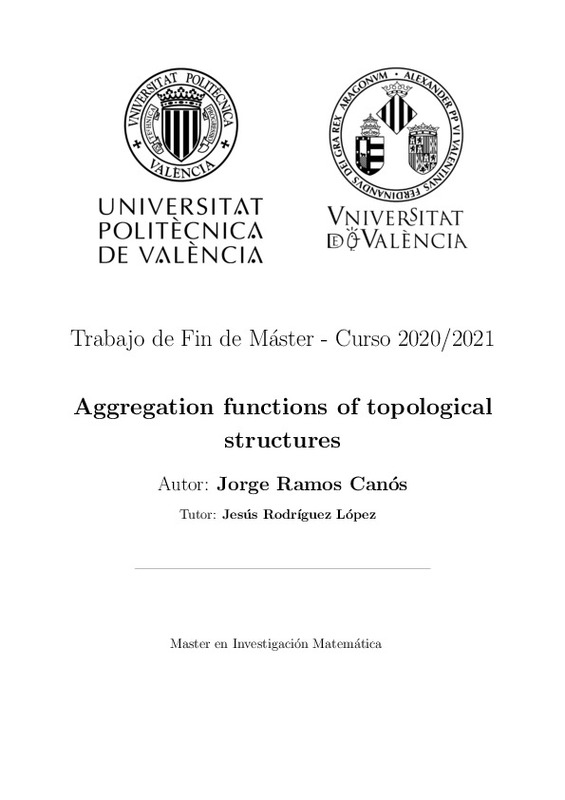|
Resumen:
|
[ES] Las funciones de agregación son un tipo especial de funciones que permiten combinar un número finito de entradas en una única salida que debe resumir de algún modo la información de todas las entradas. Como ejemplo ...[+]
[ES] Las funciones de agregación son un tipo especial de funciones que permiten combinar un número finito de entradas en una única salida que debe resumir de algún modo la información de todas las entradas. Como ejemplo paradigmático de estas funciones podemos destacar la media aritmética aunque el abanico disponible es muy amplio. El estudio de este tipo de funciones se ha convertido en un área muy activa de las matemáticas debido a su utilidad tanto en matemática pura (ecuaciones funcionales, teoría de integración, ...) como en matemática aplicada (toma de decisiones, inteligencia artificial). Además de aglutinar valores, las funciones de agregación permiten también fusionar estructuras topológicas. Por ejemplo, Dobos y sus colaboradores han estudiado el problema de determinar aquellas funciones que permiten obtener, a partir de una familia arbitraria de espacios métricos, una métrica en el producto cartesiano de dichos espacios. Este problema también se ha analizado en el caso de casi-métricas, es decir, métricas que no satisfacen necesariamente el axioma de simetría. Un problema muy interesante relacionado con este es el de caracterizar las funciones que no solo permiten hacer esta agregación de métricas sino que también conservan la topología producto, es decir, caracterizar las funciones que al agregar métricas devuelven una métrica compatible con la topología producto. Aparte del estudio de agregación de estructuras topológicas clásicas, también existen resultados sobre cómo agregar estructuras difusas. Por otra parte, también se ha investigado la agregación de otras estructuras topológicas como las normas y las normas asimétricas pero no existen resultados sobre la agregación de su correspondiente estructura difusa. Así, en este trabajo se propone al estudiante que haga un análisis de los diferentes resultados que existen sobre funciones que agregan estructuras topológicas tanto en el contexto clásico como en el difuso. Además, también se abordará el problema de obtener la caracterización de aquellas funciones que agregan normas difusas débiles. De este modo, los objetivos principales de este trabajo son: revisar el concepto de función de agregación y sus propiedades fundamentales; revisar los resultados existentes en la literatura sobre la agregación de métricas y casi-métricas; estudiar las caracterizaciones que existen sobre funciones que agregan normas y normas asimétricas; revisar algunos conceptos de la topología difusa; caracterizar las funciones que permitan agregar normas difusas y establecer una relación adecuada con las funciones que agregan métricas difusas.
[-]
[EN] Aggregation functions are a type of functions that allow us to combine a finite number of inputs into one output that in some way summarize de information of all the inputs. An example of this functions is the arithmetic ...[+]
[EN] Aggregation functions are a type of functions that allow us to combine a finite number of inputs into one output that in some way summarize de information of all the inputs. An example of this functions is the arithmetic mean, but there are lots of different possibilities. The study of these functions has become in an important area of mathematics because of their utility in pure mathematics (funcional equations, integration theory) and in applies mathematics (making decisions, artificial intelligence). Moreover, we can use aggregation functions to combine topological structures. For example, Dobos and his collaborators have solved the problem of when a function allow us to obtain from a family of metric spaces, a new metric in the Cartesian product of that spaces. This problem has been analyzed in the case of quasi-metrics, i. e. metrics that don't hold the axiom of symmetry. An interesting problem related to this one is characterizing functions that aggregate metrics and preserve the product topology. That is to say, characterize functions that when they aggregate metrics, the output is a metric compatible with the product topology. In addition to the results of functions that aggregate topological structures in the classic sense, there exist results of fuzzy structures. Moreover, there are papers about norms and asymmetric norms, but there are not results about aggregation of norms and quasi-norms in the fuzzy context. So, in this paper there is an analysis of the existing literature about functions that aggregate topological structures in the classic sense and in the fuzzy context. Moreover, we solve the problem of characterize weak fuzzy norm agrgegation functions. So the principal objectives of this paper are: Make a review of the concept of an aggregation function and its principal properties. Make a review of the existing results in the literature about aggregation functions of metrics and quasi-metrics. Study the existing characterizations about norms and asymmetric norms. Make a review about some concepts of fuzzy topology. Characterize fuzzy norm aggregation function and establish a relation between these functions and fuzzy metric aggregation functions.
[-]
|







